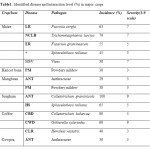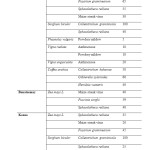Introduction
Most farmers in South omo and segen peoples of Southern Nation Nationality Peoples Region plant uncertified seed saved from the previous harvest or borrowed from neighbors or purchased from local markets, factors that encourage spread and introduction of new diseases. This trend has variously been attributed to prohibitively high prices of certified seeds, unavailability of certified seed; desire to grow new varieties and the fear of losing the traditional varieties that have special attributes (Witcombe et al., 1999; Sperling and Loevinsohn, 1993). At the same time agriculture is expanding and new areas are continually brought under cultivation due to increased population, low soil fertility, pests and disease among other factors.
Despite its importance in Ethiopian agriculture, cereals and pulses production is affected by different biotic and abiotic constraints among which anthracnose and powdery mildew is an important biotic constraint. Anthracnose, caused by Colletotrichum sublineolum, is one of the most important diseases limiting grain production in most cereals and pulses growing regions (Hulluka and Esele 1992).
Previous studies have revealed the importance of sorghum, maize, haricot bean mung bean cow pea and coffee diseases including anthracnose in the world at large and in Africa in particular (Hulluka and Esele 1992, King and Mukur 1994, and Esele 1995). However, most of the studies do not provide quantitative measurement in terms of disease severity. On the other hand such information is of paramount importance as it can be related to yield loss and hence economic impact of the disease (Jeger 1990, Ngugi et al., 2002).
Assessment of the prevalence and severity of plant diseases is important to map the geographic distribution and determine the status of the disease in addition to providing baseline data to prioritize research problems. To the best of our knowledge no such extensive and quantitative survey has been done on sorghum maize haricot bean cow pea mung bean and coffee in South omo and Segen people’s zone of Southern nation Nationality peoples Region of Ethiopia. So the objective of this survey was to assess major important plant disease affecting maize, sorghum, coffee, haricot bean, mungbean and cowpea around south Omo and Segen people Zone.
Material and Methods
Survey was conducted in South omo (Benatsemay and Debub Ari districts) and Segen Peoples zone (Konsso district), of SNNPRS of Ethiopia, in 2013 cropping season. The surveyed zones were purposively selected to represent the major sorghum, maize, haricot bean, mung bean cow pea and coffee growing areas of the region.
Sites and farmers selection were carried out through discussion with the zonal and woreda agricultural offices and through observation of secondary data and field observations of preliminary selected woreda of each zone.
Discussion with stake holders were carried out with the objective of extracting information regarding constraints on crop production specially the prevalence of important crop diseases and their distribution, damage level, area coverage, and their control measures.
During the survey period naturally infected plants of different parts (root, stem, leaf and seed) which showed suspected typical symptoms of different diseases were collected. A total of 250 samples were collected and brought to Jinka public health laboratory for isolation and identification of the pathogen.
Field inspection formats were developed to record data related to farmers’ agronomic practices like-planting methods, planting time, seed source, fertilizer application, pesticide usage and crop rotation system) during field visits. A total of 100 farmers were interviewed and their fields were observed to investigate their current cultural practice in the selected districts.
Each samples having suspected disease symptom were cut in to smaller pieces from the edge of the diseased part and surface sterilized for 3 min in 10% sodium hypochlorite solution and rinsed 5 times by changing sterile water. The sterilized pieces were put in potato dextrose agar (PDA) and Yeast Potato Sucrose Agar (YPSA) media for isolation of fungal and bacterial pathogens, respectively. After a few days of growth, each type of pathogen was purified by transferring cultures to new media. Identification at species level was made using the color of the mycelium and the morphology of the conidia. Finally each isolated pathogen was transferred to the PDA and YPSA slant media, labeled and preserved at 400c for further observation.
Results and Discussions
Assessment on major diseases of maize, sorghum, coffee haricot bean, mung bean and cow pea was undertaken at South omo zone (South Ari, and Benatsemay woreda) and Segen peoples zone (Konsso woreda).
Maize and Sorghum are the major cereal crops in South omo and Segen people’s zone. The major pathogens that cause disease in maize are Puccinia sorghi, Trichometasphaeria turcica, Fusarium graminearum, Sphacelotheca reiliana, and Maize streak virus (Tabel 2). Where as in sorghum the major diseases causing pathogen are Colletotrichum graminicola and Sphacelotheca reiliana. In addition to maize, sorghum, haricot bean, cow pea and mung bean are the major pulse crops in these zones. The pathogen that cause diseases in these pulse crops in two zones are powdery mildew and Anthracnose
 |
Table 1: Identified Disease and Interaction Level (%) in Major Crops. Click here to View table |
LR= Maize Leaf Rust, ER= Maize Ear Rot, HS=Maize Head Smut, MSV= Maize, Streak Virus, PM= Powdery Mildew, ANT= Anthracnose, CBD= Coffee Berry Disease, CWD=Coffee Wilt Disease, CLR= Coffee Leaf Rust and NCLB= Northern Corn Leaf Blight.
 |
Table 2: Identified Pathogen and Infection Level (%) in Various Crops at 3 Locations. Click here to View table |
The highest mean infection of Trichometasphaeria turcica (70%) in maize and Colletotrichum graminicola (100%) in sorghum were recorded at South ari woreda of South omo zone. Whereas at Konsso woreda of Segen peoples zone 45% of Fusarium graminearum and 100% of Colletotrichum graminicola were recorded as the highest mean infection of maize and sorghum, respectively (Table 2).
The mean infection in coffee ranged from 40% (Hemileia vastatrix) to 60% (Gibberella xylariodes) in South omo zone of South Ari woreda (Table 2) Earlier (Wallen and Sutton, 1965-; Opio et al., 1993; Sherf and MacNab, 1986 and Dinant and Lot, 1992) reported that maize, sorghum, coffee, mung bean, cow pea and haricot bean were affected by different diseases.
Conclusion and Recommendations
Even though the yield loss caused by each pathogen type is not clearly studied and quantified in the presently studied crops- , current study indicates the presence of complex diseases during different growth stage of the studied crops. In present study, incidence of five pathogens was observed in maize and sorghum crops. Whereas in mung bean and cow pea two types of pathogens were observed. The number of major pathogens that attacks coffee and Haricot bean were found to be three and one-, respectively across surveyed district. Among all diseases, fungal diseases like-powdery mildew, Phacelotheca reiliana and Anthracnose- are the most frequently encountered diseases in surveyed area.
In the future efforts should be made towards the integration of multiple control options like-development of resistance varieties, development of improved agronomic practices, awareness creation among farmers and experts right from site selection till post-harvest handling of various diseases and their management. In general holistic, cumulative integrated approach is required in all urgency to manage the complex diseases in the studied areas.
Acknowledgements
The authors are grateful to Southern Agricultural Research Institute, SARI, Ethiopia and Jinka Agricultural Research center for the financial support and vehicle facilitation.
References
- Dinant S., Lot, H. Lettuce mosaic virus. Plant pathology. 41, 528-542. (1992).
CrossRef - Esele, J.P.E. Foliar and head diseases of sorghum. African Crop Science Journal 3:185–189.(1995)
- Hulluka M and Esele JPE. 1992. Sorghum diseases in Eastern Africa. Pages 21–24 in Sorghum and millet diseases: A second world review (de Milliano WJA, Frederiksen RA and Bergston GD, eds.). Patancheru 502 324, Andhra Pradesh, India: International Crops Research Institute for the Semi-Arid Tropics.
- Jeger, M.J. Mathematical analysis and modeling of spatial aspects of plant disease epidemics. In Epidemics of plant diseases: Mathematical analysis and modeling (Kranz J, ed.). New York, USA: Springer-Verlag.(1990).
CrossRef - King, S.B and Mukuru, S.Z.An overview of sorghum, finger millet and pearl millet in eastern Africa with special attention to diseases. Pages 24–34 in Breeding for disease resistance with emphasis on durability (Danial DL, ed.). Wageningen, the Netherlands: Wageningen Agricultural University-(1994).
- Ngugi, H.K. King, S.B. Abayo, G.O and Reddy, Y.V.R. Prevalence, incidence, and severity of sorghum diseases in western Kenya. Plant Disease 86:65–70.(2002).
CrossRef - Opio, A.F., Teri, J.M., and Allen, D.J. Studies on seed transmission of Xanthomonas campestris pv. Phaseoli in common beans in Uganda. African Crop Science Journal. 1, 59-67. (1993).
- Sperling, L. – and Loevinson, M.E. The dynamics of adoption: distribution and mortality of bean varieties among small farmers in Rwanda. Agricultural Systems. 41, 441-453. (1993).
CrossRef - Wallen, V-R. and Sutton, M.D. Xanthomonas phaseoli var fuscans (Burkh) Starr & Burkh. on field bean in Ontario. Canadian Journal of Botany. 43, 437-446. (1965).
CrossRef - Witcombe, J-R., Petre, R., Jones, S. and Joshi, A. Farmer participatory crop improvement. IV. The spread and impact of a rice variety identified by participatory varietal selection. Experimental Agriculture. 35, 471-487. (1999).
CrossRef
